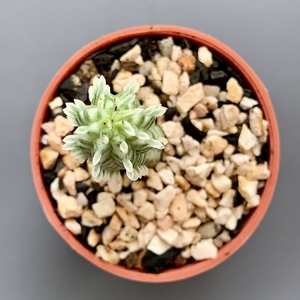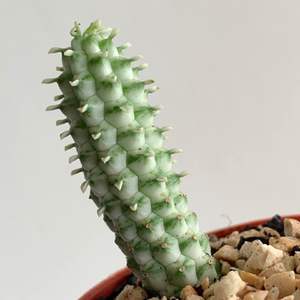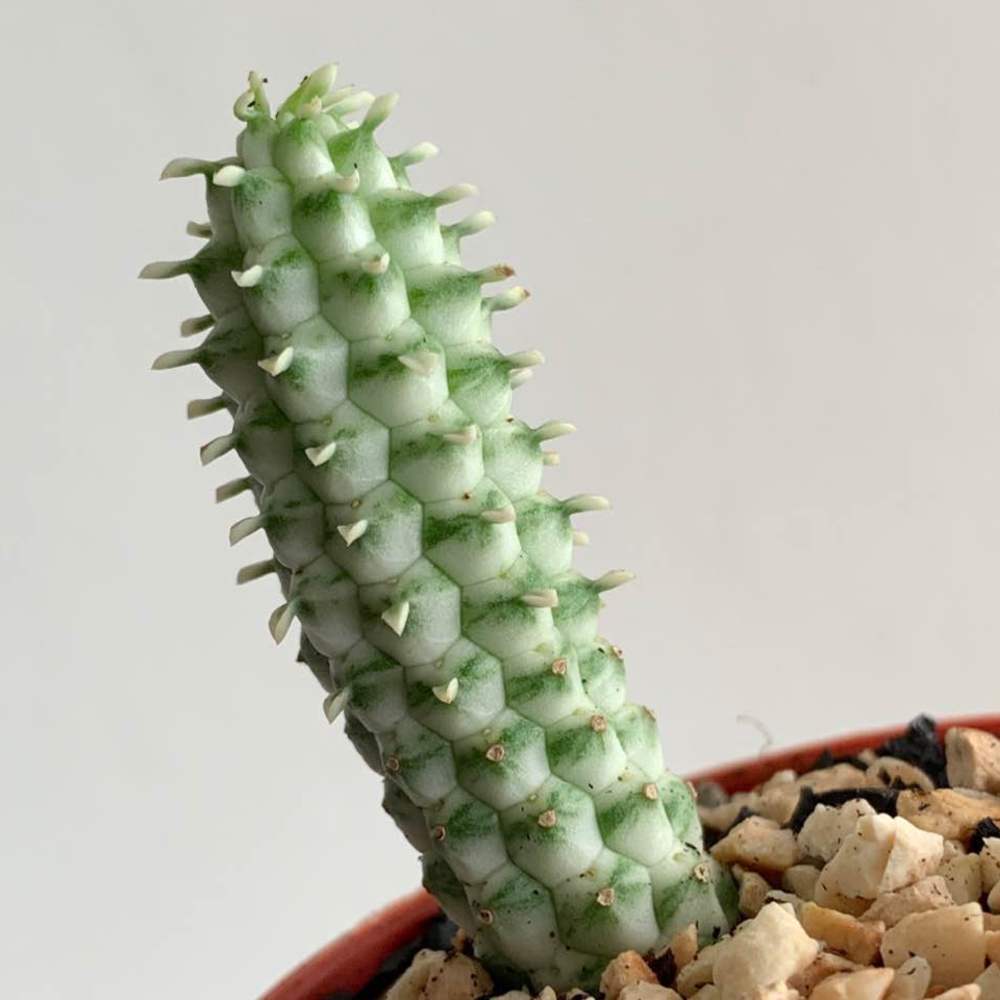植物经验
详细说明
Euphorbia mammillaris is a short stemmed, dioecious shrublet producing a dense cluster. The stem is thick, erect, simple and ribbed, deep green, up to 14 inches (35 cm) tall and up to 2.4 inches (6 cm) in diameter. Usually there are many club-like, lateral branches. The “spines” are the solitary sterile peduncles. They are occasionally present and scattered, thick, whitish and up to 0.4 inch (1 cm) long. The leaves are small, green and ephemeral. It produces yellow solitary cyathia at the tip of each stem in late winter to early summer.
Euphorbias are very easy to care for. They require a little pampering to become established, but once they are, they are self-sufficient. In fact, more die from too much care and watering than from neglect. Euphorbias need well-draining soil and lots of sunlight. They are not particular about soil pH, but they cannot tolerant wet soil. Unlike most succulents, Euphorbia does not handle long periods of drought well. It may need weekly watering during the summer. Water whenever the soil is dry several inches below the surface. Water deeply, but don’t let them sit in wet soil, which can cause root rot. Add some organic matter or fertilizer to the planting hole. If you are growing them in containers or your soil is poor, feed with a half-strength fertilizer monthly.
Euphorbia can be grown from seed, but they can be difficult to germinate (or even find). It is usually propagated by cuttings. This can be tricky, because of the exuding sap. Rooting hormone is recommended with Euphorbias. They tend to grow problem free, but there are a few pests and diseases to be alert for.
Growing Conditions
Soil: Euphorbias need well-draining soil and lots of sunlight. They are not particular about soil pH, but they cannot tolerant wet soil.
Water: Unlike most succulents, Euphorbia does not handle long periods of drought well. It may need weekly watering during the summer. Water whenever the soil is dry several inches below the surface. Water deeply, but don’t let them sit in wet soil, which can cause root rot.
Feeding: Add some organic matter or fertilizer to the planting hole. If you are growing them in containers or your soil is poor, feed with a half-strength fertilizer monthly.
Propagating
Euphorbia can be grown from seed, but they can be difficult to germinate (or even find). It is usually propagated by cuttings. This can be tricky, because of the exuding sap. Rooting hormone is recommended with Euphorbias.
Pests and Problems
Euphorbia plants tend to grow problem free, but there are a few pests and diseases to be alert for:
Mealy Bugs and Spider Mites are the most common pests. Catching them early is your pest chance for controlling them.
Root Rot was mentioned above. It is only a problem when plants are allowed to sit in wet soil.
Powdery Mildew – Although Euphorbia like humidity, they also need good air circulation or they will be susceptible to mildews. Try correcting the cultural conditions first, because strong fungicides can harm leaves.
Euphorbias are very easy to care for. They require a little pampering to become established, but once they are, they are self-sufficient. In fact, more die from too much care and watering than from neglect. Euphorbias need well-draining soil and lots of sunlight. They are not particular about soil pH, but they cannot tolerant wet soil. Unlike most succulents, Euphorbia does not handle long periods of drought well. It may need weekly watering during the summer. Water whenever the soil is dry several inches below the surface. Water deeply, but don’t let them sit in wet soil, which can cause root rot. Add some organic matter or fertilizer to the planting hole. If you are growing them in containers or your soil is poor, feed with a half-strength fertilizer monthly.
Euphorbia can be grown from seed, but they can be difficult to germinate (or even find). It is usually propagated by cuttings. This can be tricky, because of the exuding sap. Rooting hormone is recommended with Euphorbias. They tend to grow problem free, but there are a few pests and diseases to be alert for.
Growing Conditions
Soil: Euphorbias need well-draining soil and lots of sunlight. They are not particular about soil pH, but they cannot tolerant wet soil.
Water: Unlike most succulents, Euphorbia does not handle long periods of drought well. It may need weekly watering during the summer. Water whenever the soil is dry several inches below the surface. Water deeply, but don’t let them sit in wet soil, which can cause root rot.
Feeding: Add some organic matter or fertilizer to the planting hole. If you are growing them in containers or your soil is poor, feed with a half-strength fertilizer monthly.
Propagating
Euphorbia can be grown from seed, but they can be difficult to germinate (or even find). It is usually propagated by cuttings. This can be tricky, because of the exuding sap. Rooting hormone is recommended with Euphorbias.
Pests and Problems
Euphorbia plants tend to grow problem free, but there are a few pests and diseases to be alert for:
Mealy Bugs and Spider Mites are the most common pests. Catching them early is your pest chance for controlling them.
Root Rot was mentioned above. It is only a problem when plants are allowed to sit in wet soil.
Powdery Mildew – Although Euphorbia like humidity, they also need good air circulation or they will be susceptible to mildews. Try correcting the cultural conditions first, because strong fungicides can harm leaves.
花相册 (2)


kensong
2018年12月11日

This is my first growing diary. From Catuchak RM12.00









